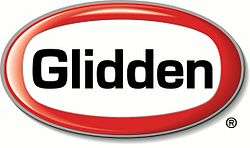Glidden (paints)
 | |
| Subsidiary | |
| Industry | Paint |
| Founded |
Cleveland, Ohio, U.S. (1875) |
| Founder | Francis Harrington Glidden, Levi Brackett and Thomas Bolles |
| Headquarters | Strongsville, Ohio, U.S. |
Area served | North America |
| Products | Paint, Home improvement products |
| Revenue | $1.5 billion (2011) |
| Parent | PPG Industries |
| Website |
glidden |
The Glidden Company is a division of PPG Industries, which is one of the largest paint manufacturers in North America. Its products are marketed under the brands "Glidden" for professional and consumer paints, "Flood" for wood stains, and "Liquid Nails," which is a contact adhesive. Glidden also manufactures paints under the brand names America's Finest, Speed-Cote, and Ralph Lauren.[1] It is the third largest maker of paint in the United States.[2]
Glidden was purchased by British conglomerate ICI in 1986, which in turn was later acquired by Dutch conglomerate AkzoNobel in 2008. PPG Industries announced an agreement to acquire Glidden from AkzoNobel for $1.05 billion on December 14, 2012. The transaction closed April 1, 2013.[3] Following the deal, PPG will be the second largest paint manufacturer in North America, behind Sherwin-Williams.[4] The Glidden subsidiary is headquartered in Strongsville, Ohio, a suburb of Cleveland.
History
Glidden was started in Cleveland, Ohio, in 1875 by Francis Harrington Glidden, Levi Brackett and Thomas Bolles.[5] It began making varnishes for furniture, pianos, carriages, and wagons.[6] It expanded greatly, opening a 17-acre varnish factory in 1908 which was claimed to be the largest in the world.[7]
It was initially named the Glidden, Brackett & Company and was renamed later to the Glidden & Joy Company,[5] and in 1890 incorporated as The Glidden Varnish Company.[5] Francis Glidden retired from the business at the age of 85, turning the company over to Adrian D. Joyce and his associates after a public sale. Joyce became president when Glidden was incorporated in 1917, a title he would retain until 1950, when his son, Dwight P. Joyce, succeeded him. Joyce rolled up ten paint and varnish competitors in his first two years at the helm.
During the Roaring Twenties, Joyce greatly expanded the company by integrating vertically through the acquisition of chemical and pigment companies, and creating The Glidden Food Products Co. in 1920.[6]
In 1967, Glidden merged with SCM Corporation and became the Glidden-Durkee Division of that company. In less than 10 years, the division became responsible for two thirds of SCM's sales. SCM was acquired by Hanson Trust, PLC, in 1986; Hanson sold the Glidden Division (retaining Durkee foods) to Imperial Chemical Industries. ICI was bought by the Dutch company AkzoNobel in 2008; Akzo Noble was bought by Pittsburgh's PPG in 2013. [8]

References
- ↑ Glidden Professional Paint Products. Retrieved September 7, 2016
- ↑ "The Glidden Company", Company Histories and Profiles. Retrieved November 29, 2011
- ↑ PPG to acquire piece of AkzoNobel in $1.05 billion transaction, Pittsburgh Post-Gazette. Retrieved December 14, 2012.
- ↑ Akzo Nobel sells Glidden and rest of U.S. house paints division including Strongsville headquarters. Cleveland.com. Retrieved December 14, 2012.
- 1 2 3 Orth, Samuel Peter; Clarke, S.J. (1910). A History of Cleveland, Ohio: Biographical (Google ebook ed.). Chicago-Cleveland: S.J. Clarke Pub. p. 660. OCLC 732890.
- 1 2 The Glidden Company History. Retrieved December 14, 2012.
- ↑ Thomas A. Kinney (2004), The Carriage Trade, p. 126, ISBN 9780801879463
- ↑ "Glidden Coatings and Resin Division ICI". Encyclopedia of Cleveland History. Case Western Reserve University. 27 August 2014. Retrieved 15 December 2015.
External links
| Wikimedia Commons has media related to Glidden. |
- Glidden website
- Jap-A-Lac, Glidden Varnish Company, 1890 Kenneth Franzheim II Rare Books Room, William R. Jenkins Architecture and Art Library, University of Houston Digital Library.